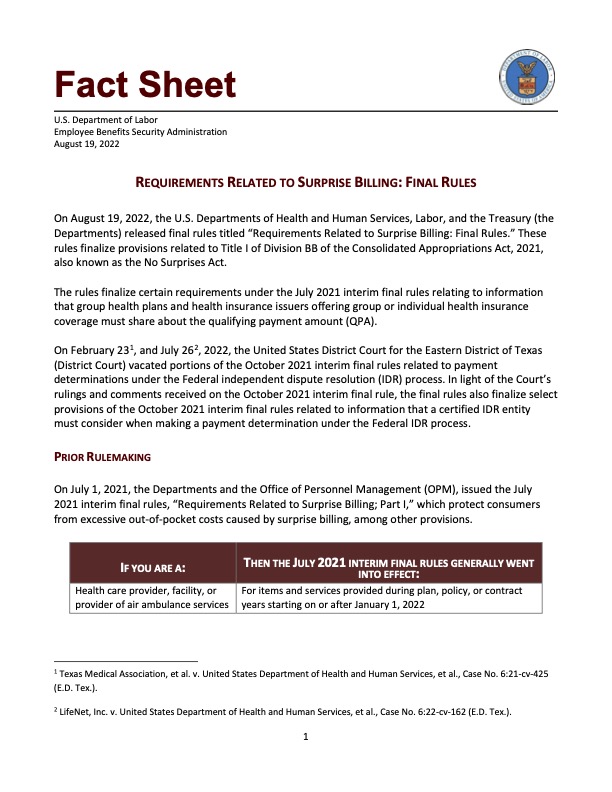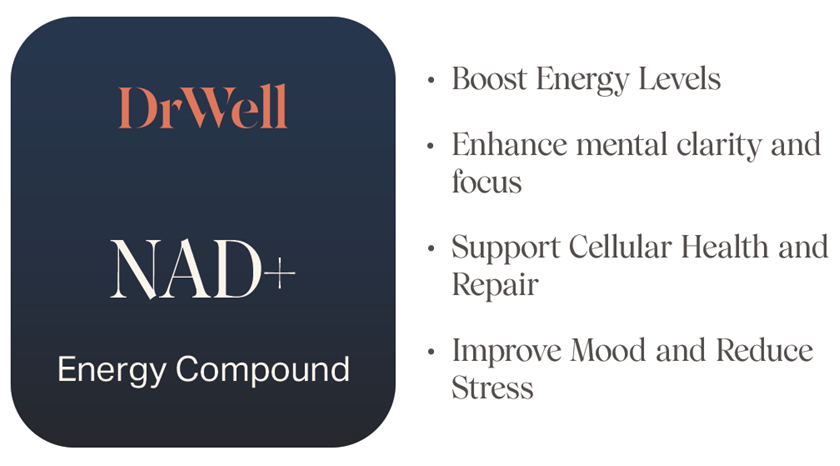Fact Sheet
U.S. Department of Labor
Employee Benefits Security Administration August 19, 2022
REQUIREMENTS RELATED TO SURPRISE BILLING: FINAL RULES
On August 19, 2022, the U.S. Departments of Health and Human Services, Labor, and the Treasury (the Departments) released final rules titled “Requirements Related to Surprise Billing: Final Rules.” These rules finalize provisions related to Title I of Division BB of the Consolidated Appropriations Act, 2021, also known as the No Surprises Act.
The rules finalize certain requirements under the July 2021 interim final rules relating to information that group health plans and health insurance issuers offering group or individual health insurance coverage must share about the qualifying payment amount (QPA).
On February 231, and July 262, 2022, the United States District Court for the Eastern District of Texas (District Court) vacated portions of the October 2021 interim final rules related to payment determinations under the Federal independent dispute resolution (IDR) process. In light of the Court’s rulings and comments received on the October 2021 interim final rule, the final rules also finalize select provisions of the October 2021 interim final rules related to information that a certified IDR entity must consider when making a payment determination under the Federal IDR process.
PRIOR RULEMAKING
On July 1, 2021, the Departments and the Office of Personnel Management (OPM), issued the July 2021 interim final rules, “Requirements Related to Surprise Billing; Part I,” which protect consumers from excessive out-of-pocket costs caused by surprise billing, among other provisions.
Health care provider, facility, or For items and services provided during plan, policy, or contract provider of air ambulance services years starting on or after January 1, 2022
1 Texas Medical Association, et al. v. United States Department of Health and Human Services, et al., Case No. 6:21-cv-425 (E.D. Tex.).
2 LifeNet, Inc. v. United States Department of Health and Human Services, et al., Case No. 6:22-cv-162 (E.D. Tex.).
|
IF YOU ARE A: |
THEN THE JULY 2021 INTERIM FINAL RULES GENERALLY WENT INTO EFFECT: |
1
|
Group health plan, issuer of group or individual or health insurance coverage, or Federal Employees Health Benefits Program carrier |
For plan, policy, or contract years starting on or after January 1, 2022 |
The July 2021 interim final rules:
• Provide protections against balance billing and out-of-network cost sharing with respect to emergency services, non-emergency services furnished by nonparticipating providers at certain participating health care facilities, and air ambulance services furnished by nonparticipating providers of air ambulance services.
o Patient cost-sharing, such as coinsurance or a deductible, cannot be higher than if the service was provided by an in-network provider, facility, or provider of air ambulance services and must count toward any in-network deductible and out-of-pocket maximum.
- Provide protection against balance billing and out-of-network cost sharing for non- emergency ancillary services (such as those provided by an anesthesiologist or assistant surgeon) that are furnished by an out-of-network provider in connection with non- emergency care at certain in-network facilities.
- Provide protection against balance billing and out-of-network cost sharing for certain post-stabilization services, and certain non-emergency services performed by nonparticipating providers at participating health care facilities, when the provider or facility has not obtained the patient’s consent to waive the balance billing protections.
o Health care providers and facilities must provide patients with a plain-language
notice explaining the protections against surprise billing.
• Require plans and issuers to disclose the QPA to out-of-network providers, facilities, and
providers of air ambulance services with each initial payment or notice of denial of payment for each item or service when the QPA serves as the amount upon which cost sharing is based.
On October 7, 2021, the Departments and OPM issued the October 2021 interim final rules “Requirements Related to Surprise Billing; Part II,” which established the Federal IDR process, good faith estimate (GFE) requirements for uninsured (or self-pay) individuals, and the patient-provider dispute resolution (PPDR) process. The interim final rules also implemented the external review provisions of the No Surprises Act.
Health care provider, facility, or For items and services provided during plan, policy, or contract provider of air ambulance services years starting on or after January 1, 2022
|
IF YOU ARE A: |
THEN THE OCTOBER 2021 INTERIM FINAL RULES WENT INTO EFFECT: |
2
|
Group health plan, health insurance issuer, or Federal Employees Health Benefits Program carrier |
For plan, policy, or contract years starting on or after January 1, 2022 |
With respect to the Federal IDR Process, the October 2021 interim final rules:
- Establish the Federal IDR process that nonparticipating providers or facilities,
nonparticipating providers of air ambulance services, and plans or issuers in the group and individual markets may use to determine the out-of-network rate for applicable services if they cannot reach a negotiated settlement
- Implement the IDR entity certification process and provide guidance on what arbitrators must demonstrate to become a certified IDR entity.
SUMMARY OF THE AUGUST 19, 2022 FINAL RULE INFORMATION ABOUT THE QPA THAT PLANS AND ISSUERS MUST SHARE
The July 2021 interim final rules require plans and issuers to disclose the QPA for each item or service to providers, facilities, and providers of air ambulance services with each initial payment or notice of denial of payment when the QPA serves as the amount upon which cost sharing is based.
In order to ensure that providers, facilities, and providers of air ambulance services have the information they need to engage in meaningful open negotiations—and in response to comments from stakeholders—the Departments are finalizing a definition of the term “downcode” and requiring that plans and issuers disclose additional information if they downcode a billed claim. Although “downcoding” is being defined for the first time in these final rules, the concept was reflected in both sets of interim final rules. Though neither set of interim final rules specifically defines a term for this practice, the interim final rules described the practice and explained that it was permissible under certain circumstances.
The final rules define the term “downcode” to mean the alteration by a plan or issuer of the service code to another service code or the alteration, addition, or removal by a plan or issuer of a modifier, if the changed code or modifier is associated with a lower QPA than the service code or modifier billed by the provider, facility, or provider of air ambulance services.
If a QPA is based on a downcoded service code or modifier, the plan or issuer must provide the following with its initial payment or notice of denial of payment:
- a statement that the service code or modifier billed by the provider, facility, or provider of air ambulance services was downcoded;
- an explanation of why the claim was downcoded, including a description of which service codes or modifiers were altered, added, or removed, if any; and
- the amount that would have been the QPA had the service code or modifier not been downcoded.
PAYMENT DETERMINATIONS UNDER THE FEDERAL IDR PROCESS
3
Initially, the October 2021 interim final rules required that certified IDR entities select the offer closest to the QPA, unless the certified IDR entity determined that any additional credible information submitted by the parties demonstrated that the QPA was materially different from the appropriate out-of-network rate. The District Court vacated this requirement in rulings in February and July 2022. Therefore, these final rules remove the provisions that the District Court vacated. These final rules specify that certified IDR entities should select the offer that best represents the value of the item or service under dispute after considering the QPA and all permissible information submitted by the parties.
Under these final rules, certified IDR entities must consider the QPA and then must consider all additional permissible information submitted by each party to determine which offer best reflects the appropriate out-of-network rate. The additional information may not include information prohibited by the statute. Certified IDR entities should evaluate whether the information relates to the payment amount offer submitted by either party and whether the additional information is credible. The certified IDR entity should also evaluate the information to avoid double counting information that is already accounted for by the QPA or by any of the other information submitted by the parties. After weighing these considerations, certified IDR entities should then select the offer that best represents the value of the item or service under dispute.
The final rules also finalize provisions of the October 2021 interim final rules requiring certified IDR entities to explain their payment determinations and underlying rationale in a written decision submitted to the parties and the Departments.
The final rules require that the written decision include an explanation of the information that the certified IDR entity determined demonstrated that the selected offer is the out-of-network rate that best represents the value of the item or service. This includes the weight given to the QPA and any additional credible information regarding the relevant factors.
If the certified IDR entity relies on additional information or circumstances when selecting an offer, the final rules state that its written decision must include an explanation of why the certified IDR entity concluded the information was not already reflected in the QPA.




